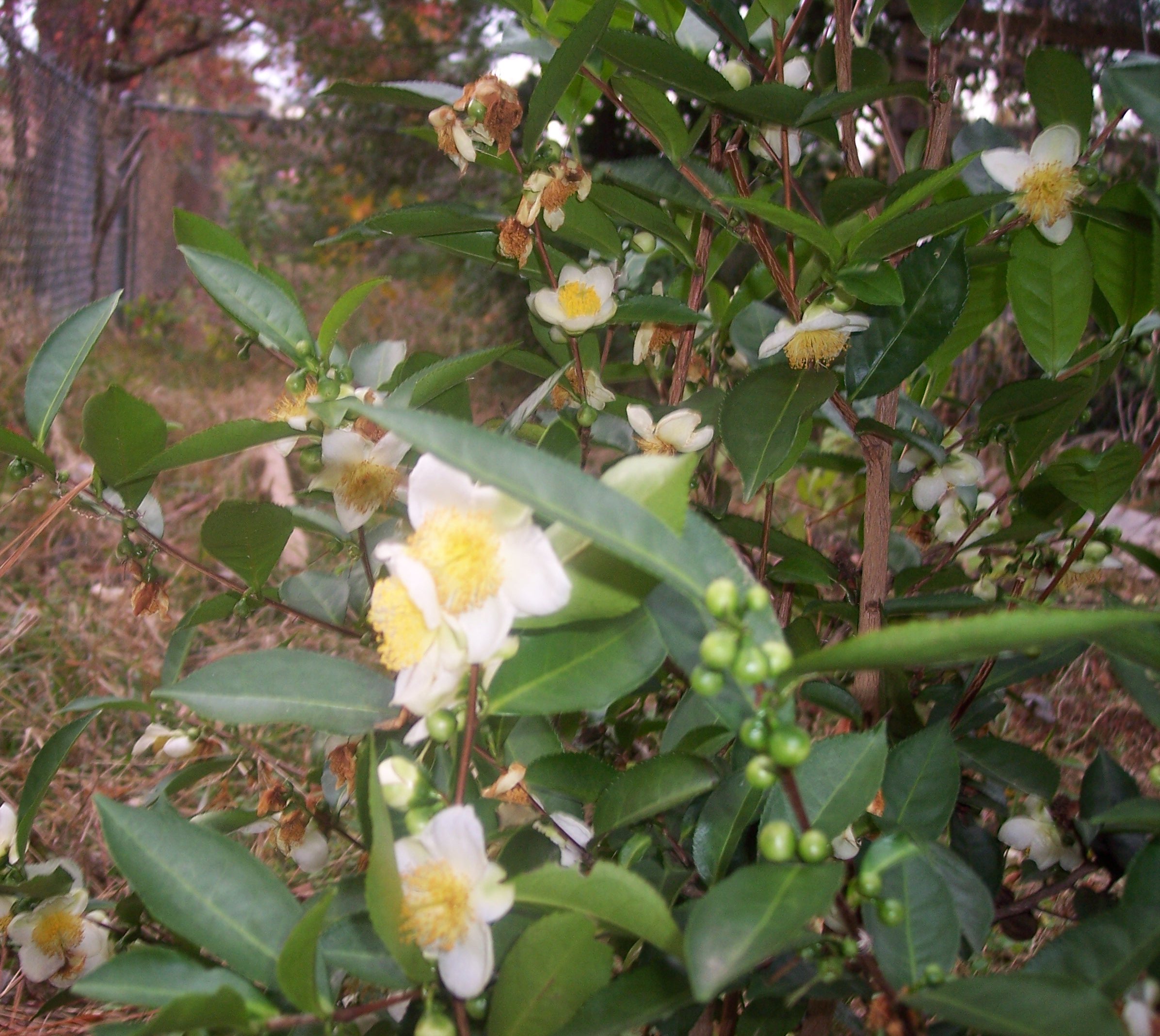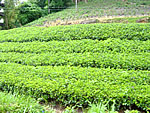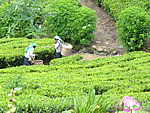|
Camellia Assamica
TEA
Family:
Theaceae (tea family)
Common Names:
tea, tea plant, tea tree

Grow your own Tea - Camelia Assamica
Sinensis Ruticae
This Tea Plant was grown in Prattville,
Alabama
Alabama is classified as
humid subtropical (Cfa)
under the
Köppen climate
classification.
The tea plant can handle a light frost and even snow, but
not heavy freezes or prolonged cold winters, and, unlike some plants, it does
not require a period of cold dormancy. It can thus grow from subtropical
climates to tropical climates, but generally requires a fair amount of humidity
and rainfall during the growing season. Although Tea can grow
in hot tropical climates if they are sufficiently humid,
the highest-quality teas mostly come from subtropical climates
with some seasonality.

Tea
plants bloom in the autumn with fragrant, nodding cup shaped flowers about 1 in
(2.5 cm) wide. The seven or eight petals are white. In commercial tea
plantations, such as the one pictured here in the Badulla District of Sri Lanka.
The plants are kept pruned to about 4 ft (1.2 m) tall and flowers are rarely
produced.
There are two basic
varieties of Tea. The typical variety (var.
sinensis) is
probably native to western China. It has been cultivated for centuries, mostly
in plantations in China and at high elevations in tropical southern Asia. More
recently it is being cultivated in other areas of the world with suitable mild
and humid climates.
Assam
tea,
the tea featured here, (var.
assamica) occurs
naturally in tropical and subtropical southeastern Asia and is cultivated
extensively in India and Sri Lanka.
Tea Culture
Light:
Seedlings and young tea plants should be shaded; mature plants produce best in
full sun.
Moisture: Tea plants
need plenty of moisture. They do best in rather humid climates.
Hardiness: USDA
Zones 9 - 11. Tea plants do best in a cool, but frost-free climate. They can,
however, withstand light freezes when dormant.
Tea Usage
The
process for making black tea originated in China, and was transplanted by the
British to India and then Ceylon (Sri Lanka) in the last century, and to Kenya
and Mauritius in this century. Like Coffee plants, tea plants (camelia
assamica) like hot
days, cool nights, and plenty of rain. With the exception of Assam, most teas
are grown in mountainous regions. During the growing season, tea is harvested
every seven days.

The tender young leaves
from tea plants are plucked and variously "fermented" (actually oxidized - no
yeast or microbes are involved), then dried to make green, black or oolong teas.
Green tea is made from fresh leaves that are steamed and wilted, then dried
immediately. Black tea is made from leaves that are wilted and crushed in
rollers, then allowed to oxidize for several hours before they are dried.
Only the two tender
uppermost leaves and terminal buds are plucked by hand. After this gentle
beginning, the leaves are left in hot rooms to wither and then put through a
roller to release their juices.
These juices react with the
air (oxidation) and turn the leaves black and impart a flavor we love. The teas
is then dried in ovens and graded accordingly to size. This grading process
gives rise to those confusing initial:
OP
Orange Pekoe
BP
Broken Pekoe
BOP
Broken Orange Pekoe
CTC
Curl Twist and Cut
FTGFOP
Fancy Tippy Golden Flowery Orange Pekoe
Generally the more initials, the finer the tea.
Black Teas
Oolong
tea comes from
leaves that are only partially oxidized before drying. Black teas are graded by
the size of the particles. This is important since larger pieces take longer to
brew.
Pekoe
teas are supposedly
the highest quality black teas, made from the youngest, "first flush" of leaves.
Orange Pekoe is the
best, made into long, thin, twisted leaves; regular
Pekoe
tea leaves are more open.
Souchong
teas are black teas
with larger open, coarse leaves.
India produces primarily
black teas, including the full-bodied
Assam
tea
and the delicateDarjeeling,
sometimes called the "champagne of teas."
Earl Grey is a black
tea flavored with oil of bergamot (a type of sour orange,
Citrus
aurantium). Teas are
sometimes flavored with jasmine flowers, orange blossoms (Citrus
sinensis), rose
petals, apples or mangos.
Green Teas
Green Teas are graded based
on the age of the leaves and the method of preparation.
Gunpowder
teas consist of
little tightly rolled balls of young leaves; they produce a pale-colored green
tea known for its sharp, distinctive flavor.
Imperial
is like Gunpowder but with larger, looser pieces of leaf.
Tea and Health
Tea, as a beverage, was
introduced into Europe during the middle of 16th century. By the 1700's it began
to replace beer as the beverage of choice at breakfast.
Today it is prized for more
than its use as a beverage. Recent research has given evidence that tea contains
components that inhibit tooth decay. Other findings indicate that green tea
properties aid digestion, help to ward off cancers, and that people who drink at
least one cup of tea a day have a lower risk of heart disease, stroke and
cancer.
Green tea contains more
flavanols, flavandiols, flavonoids, and phenolic acids, which are antioxidant in
nature than any other fruit or vegetable.
Polyphenols are members of the flavonoid family. Each of these structures has
chemicals attached to it called phenol groups. These compounds account for up to
30% of the dry weight of green tea leaves. Most of the polyphenols present in
green tea are flavanols, commonly known as catechins made of several ring-like
structures.
The major catechins present
in green tea are:
· epicatechin
(EC)
· epicatechin-3-gallate
(ECG)
· epigallocatechin
(EGC)
· epigallocatechin-3-gallate
· (EGCG)
Antioxidants are the
chemicals endowed with the ability to counteract the adverse effects of damaging
free radicals
(highly unstable molecules) produced in the body by normal metabolism and by
exposure to radiation, chemicals and heavy metals. Free radicals damage cells,
proteins and fats in the body, theoretically causing a wide range of diseases
including the aging process. By trapping these oxidant radicals, the
antioxidants reduce their effective bio-availability. This represents a highly
efficient built-in preventive machinery within a living cell. The water-extract
of the dry tea leaves, as is consumed by humans, contains many compounds
including a mixture of polyphenols.
The major polyphenolic
antioxidants present in black tea are:
· theaflavins
such as theaflavin-3-gallatetheaflavin-3'-gallae, theaflavin-3,3'-digallate
· thearubigens
and their derivatives such as theafulvins and theacitrins
· tannins
such as pentagalloylglucose and camelliatanin A.
Many studies have shown
that green tea, either consumed internally or applied directly to the body, can
protect lab animals against breast, colon, skin, liver, stomach, pancreas,
prostrate and esophagus cancers. It appears that tea can kill or slow the growth
of cancer cells while leaving normal cells unscathed. Some studies have shown
that tea consumption may reduce the risk of stroke. In one study it was found
that a long-term administration of either 0.5% EGCG or 0.5% persimmon tannin to
SHRSP inhibited the incidence of stroke and prolonged the life span.
Green
teas have been studied the most, but black and oolong teas may be just as
effective. To get the most benefit, steep tea bags for a full five minutes in
boiled water.
Brewing Your Own Fresh Tea
Boil Water and allow it to
settle for 3 minutes
Add half a teaspoon (2-3
grams) of green tea
steep for 3 minutes and then
pour
can be flavored with Ginger
can also be refrigerated and
enjoyed cold
|

